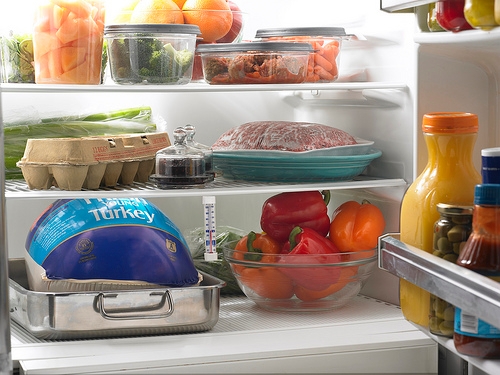Avoid misgivings about food safety at Thanksgiving
I am a terrible cook. My brother is an excellent cook. One year he told me his turkey was thawing in the bathtub because it was too big for the refrigerator and my enthusiasm for dining at his house began to cool.
“The prevention plan for food safety begins with planning the feast, knowing when a frozen turkey needs to start defrosting in the refrigerator so there is ample time to thaw,” says Connie Schneider, director of UC Agriculture and Natural Resources Youth, Families and Communities Statewide Program. “What size turkey will you defrost? Is there enough space to thaw the turkey safely?”
To avoid making diners sick, the traditional fowl should be thawed at temperatures below 40 degrees F. The "Danger Zone," temperatures where foodborne bacteria multiply rapidly, is between 40 and 140 degrees F.
“People thaw on the counter, they put their turkeys in the garage to thaw out,” says Schneider, in a “can you believe there are such fools?” tone that warns me that I should not admit to doing this. “They also place dinner leftovers, especially the big turkey, in the garage because of lack of refrigerator space.”
The registered dietitian advises, “When using refrigerator thawing, place the turkey in its original wrapping placed in a pan, which prevents dripping as turkey defrosts.”
A whole turkey weighing 4 to 12 pounds takes 1 to 3 days to thaw in a refrigerator. Heavier turkeys take longer. A thawed turkey can remain in the refrigerator for 1 or 2 days before cooking.
If your turkey weighs more than 12 pounds and today is Tuesday and you haven’t begun thawing it, you may have to resort to Plan B for thawing the bird or ordering Chinese food on Thursday.
According to the USDA Food Safety and Inspection Service website, there are three safe ways to thaw food: in the refrigerator, in cold water and in the microwave oven. Procrastinators will be thawing their birds in cold water or in the microwave. For details on quicker thawing, see the USDA website: http://www.fsis.usda.gov/wps/portal/fsis/topics/food-safety-education/get-answers/food-safety-fact-sheets/poultry-preparation/turkey-basics-safe-thawing/ct_index.
Schneider also reminds us to prevent cross-contamination of foods. For example, don’t wash or rinse the turkey before cooking because the rinse water may splash bacteria around the sink, which can then come into contact with other foods and utensils. Another way to prevent cross-contamination is prepping the stuffing ingredients before you handle the raw turkey. Keep the raw turkey and their juices away from other foods. After you prep your raw turkey, wash the cutting board, knife, sink and counter tops with hot, soapy water. Sanitize cutting boards with a solution of 1 tablespoon of unscented, liquid chlorine bleach in 1 gallon of water. Wash your hands with soap and warm water frequently and always after handing raw foods. And for crying out loud (to invoke a phrase my late father used), don’t wipe your dirty hands on a towel that will be used to dry clean dishes later!
Planning is also needed for storing leftover food after the meal, cautions Schneider. “Everyone loves leftovers, but make sure you have adequate refrigeration space.”
She recommends wrapping leftovers in airtight packaging or sealing in storage containers. This helps keep out bacteria while keeping your food moist and preventing your prized family dishes from picking up odors from other foods being stored in the fridge. For faster cooling, break up large amounts of food into smaller containers.
“Toss out any food that has been left out for more than 2 hours at room temperature!” Schneider admonishes. “Don’t allow your turkey to sit out, slice up the leftovers and refrigerate or freeze them right after your meal!”
Delicious leftovers that have been stored in the refrigerator can be enjoyed for 3 to 4 days. If you freeze them, you can eat them 3 or 4 months from now.
This Thanksgiving, I will be thanking God for allowing my family and me to survive our lackadaisical food handling on previous holidays. Happy Thanksgiving to you and your loved ones!
For more information on food safety, visit http://www.fsis.usda.gov/wps/portal/fsis/topics/food-safety-education/get-answers/food-safety-fact-sheets/safe-food-handling/keep-food-safe-food-safety-basics/ct_index.


